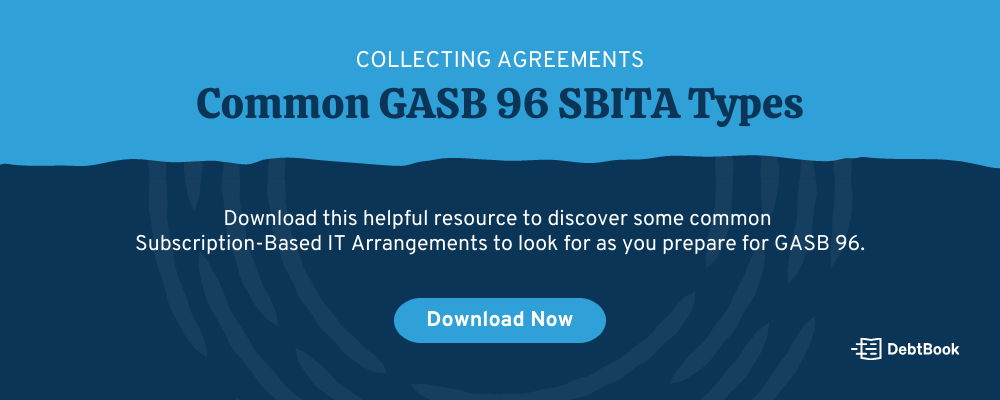Are you ready for GASB 96?
If the answer to that question is “no,” not to worry. The Governmental Accounting Standards Board (“GASB”) has applied the effective date of GASB 96 to reporting periods starting after June 15, 2022, meaning entities with a June 30th fiscal year-end will be the first to implement for their fiscal year 2023.
GASB 96 requires subscription-based IT arrangements (SBITAs) to be reported on the face of the financial statements and enhances the relevance and reliability of a government’s SBITA information. This shift means more work to be done for finance teams that are already understaffed throughout the country.
We’ve assembled this eight-step GASB 96 guide to break down the preparation process into bite-sized pieces for you and your team.
Step 1: Creating Your Implementation Roadmap
Step 2: Collecting Your Subscription-Based IT Arrangements (SBITAs)
Step 3: Extracting the Data
Step 4: Crafting the Initial Schedules
Step 5: Launching the Internal Review Process
Step 6: Understanding the Importance of Journal Entries
Step 7: Preparing Note Disclosures
Step 8: Adhering to Ongoing Compliance
Step 1: Creating Your Implementation Roadmap
The new GASB 96 standard requires governments to record both subscription assets and liabilities for SBITAs. The first step to preparing for GASB 96 is creating your implementation roadmap, starting with the steps necessary to meet the compliance deadline.
Creating a roadmap will allow teams to fully understand the new requirements, determine who will be primarily responsible for each step of implementation, and establish a realistic timeline.
Simplify your implementation with DebtBook.
Step 2: Collecting Your Subscription-Based IT Arrangements (SBITAs)
As technology evolves and cloud-based software becomes the norm, licenses and agreements have increasingly become available online. With such agreements, organizations can enter subscription-based contracts that provide governments access to a vendor’s IT software over a specified period of time.
These new types of licenses have created the need for governments to track and report their subscription-based IT arrangements (SBITAs). Essentially, SBITAs grant governments a license or title to the IT software and associated tangible capital assets.
To determine whether a contract conveys control of the right to use the underlying IT assets, a government should assess whether or not it has both of the following:
- The right to obtain the present service capacity from use of the underlying IT assets as specified in the contract
- The right to determine the nature and manner of use of the underlying IT assets in the contract
Who to Collaborate With
To ensure completeness and avoid potential risks, accounting experts suggest gathering all possible SBITAs and assessing each contract to determine if it is a SBITA or not. Since every department could have software specific to their needs, use this list to start thinking of who you’ll need to meet with.
- IT Department
- Department Heads
- Procurement
Common GASB 96 Subscription Types
Step 3: Extracting the Data
There are four key data extraction categories for IT agreements under GASB 96:
- Length of the subscription term, including extension options and termination options
- Subscription payment amounts for inclusion in the subscription liability
- Payments made, or incentives received at commencement for inclusion in the subscription asset
- Expenses other than subscription payments
The subscription term includes (a) the period during which a government has a non-cancellable right to use the underlying IT assets, and (b) periods covered by an option to extend or to terminate the agreement.
From there, gather all of the payment data including fixed payments, variable payments based on an index or rate, variable payments that are fixed in substance, incentives or prepayments made after the commencement date, deposits, and other payments that are reasonably certain of being required.
Then, identify any incentives or prepayments that were made at or before the commencement date. For agreements that commenced prior to your restatement date, only the remaining term and payments should be considered under the standard.
What is the restatement date? According to the GASB 96 standard, the restatement date is the first day of the fiscal year that your organization is implementing GASB 87 or 96.
Read the example below for more clarification.
The GASB 96 standard examines the facts and circumstances of your agreements as of your entity's restatement date. The requirements of GASB 96 are effective for fiscal years beginning after June 15, 2022, and all reporting periods thereafter. For example:
- If your entity follows a 6/30 Fiscal Year and does not report comparatively, your restatement date would be 7/1/2022. Only the remaining term, payments, and facts as of your entity's restatement date are considered under the GASB 96 standard. Please keep this in consideration while reading the remainder of Step 3 (important note: if you entered into a 5-year subscription on 7/1/2020 and your restatement date is 7/1/2022, your subscription would have a 3-year term, not a 5-year term).
The subscription asset should be initially measured as the sum of (1) the initial subscription liability amount, (2) payments made to the SBITA vendor before the commencement of the subscription term, and (3) capitalizable implementation costs, less any incentives received from the SBITA vendor at or before the commencement of the subscription term.
A government should recognize the amortization of the subscription asset as an outflow of resources over the shorter of the subscription term or the useful life of the underlying IT asset.
Tip:
Invite the internal department manager that entered into the SBITA to participate in the data extraction process. They know their contracts better than anyone, and they will be able to help identify information that may otherwise be missed.
Finally, GASB 96 lease management software identifies project expenses, which are expenses outside of just recurring subscription fees that need to be considered. To effectively ensure all of the expenses are represented, you must identify each expense associated with each SBITA project and then determine which stage of implementation each expense falls under.
There are three stages of implementation used to categorize each expense.
1. Preliminary Project Stage
Activities in this stage include the conceptual formulation and evaluation of alternatives, the determination of the existence of needed technology, and the final selection of alternatives for the SBITA.
2. Initial Implementation Stage
Activities in this stage include ancillary charges related to designing the chosen path, such as configuration, coding, testing, and installation associated with the government’s access to the underlying IT assets. Other ancillary charges necessary to place the subscription asset into service should also be included in the stage. The initial implementation stage for the SBITA is completed when the subscription asset is placed into service.
3. Operation and Additional Implementation Stage
Activities in this stage include maintenance, troubleshooting, and other activities associated with the government’s ongoing access to the underlying IT assets.
Each expense and its corresponding stage must be identified to ensure that they are properly accounted for.
Note: Don’t overlook the expenses that start before paying the annual fee or any additional expenses for implementing the system or adding additional modules at a later date.
Step 4: Crafting the Initial Schedules
While populating the schedules isn’t inherently complex, it’s crucial to make sure that all data is correctly input into a centralized location so all project expenses and balances are correctly presented in the financial statements.
To create your schedules, you will need the following data for each subscription: Interest Rate, Subscription Term, Subscription Payments, Payment Dates, and Ending Balance (if applicable).
Once this data has been extracted from the agreement and compiled, you can calculate your beginning subscription liability balance. The subscription liability should be initially measured at the present value of subscription payments expected to be made during the subscription term.
Future subscription payments should be discounted using the stated/implicit/incremental borrowing rate. The balance of the subscription liability will be reduced by your subscription payments, with interest being recognized as well.
The subscription asset should be initially measured as the sum of the initial subscription liability amount, any payments made to the IT software vendor before commencement of the subscription term, and any capitalizable implementation costs, less any incentives received from the SBITA vendor at or before the commencement of the subscription term. The subscription asset is amortized in a straight-line manner over the course of the subscription term.
Tip:
Be sure to also address any purchase options and terminations in the agreement as these will impact your contract term and the associated schedules.
Step 5: Launching the Internal Review Process
It’s time to start reviewing the work. The initial review of the contracts should be laid out fairly early on in the process so those responsible have more than enough time to conduct a comprehensive review of each step of the process. Remember, all IT agreement details must be added or corrected before moving on to the next step to avoid having incomplete SBITA schedules.
Tip:
Ask yourself if your organization has time to commit to multiple review stages, or if you need assistance with this step. Find an advisor early on in the process so you can determine what level of involvement you may need from them, as well as their associated fees. Working with a CPA or specialist who offers expert assistance and resources can significantly accelerate this process for you and your team.
Step 6: Understanding the Importance of GASB 96 Journal Entries
While not as complex as some of the other steps, the journal entries are the mechanism for ensuring the financial statements comply with GASB 96. A restatement entry is required for any prior periods that are being presented. Keep in mind, as with any journal entries related to a new standard, these GASB 96 journal entries are highly susceptible to auditor scrutiny, so don’t hesitate to reach out for additional review or help with these entries.
Step 7: Preparing Note Disclosures
Under the new standard, specific disclosures are required for IT agreements. Thus, as you near the end of this compliance process, carefully reviewing and preparing disclosures will be another crucial step.
In addition to the terms and subscription values themselves, governments should disclose:
- Information about contracts that include both SBITA and non-SBITA components and how the contract price was allocated between the two
- Accumulated amortization for each right-to-use subscription asset
- Principal and interest split for subscription payments
- Payments to be made to the vendor not already reflected in the subscription liability
Step 8: Adhering to Ongoing Compliance
Preparing and implementing a framework for compliance with GASB 96 is a complex undertaking, so it’s important to set your organization up for success from the start by carefully reviewing every contract and agreement and organizing them in a sustainable system.
The first year will be the most challenging, but once all information has been properly input into a centralized location, your team will have developed the framework for compliance with not just GASB 96, but later pronouncements as well. This will also help the organization to avoid future issues with auditing or handling complex contracts going forward.
Be sure to continue carefully documenting as you go, creating a comprehensive record outlining the phases and processes that were utilized when developing this framework. This will guide future plans to develop formal policies and outline what the review procedures look like from start to finish.
In the end, it’s imperative that your organization does not wait until the last minute to document who the responsible parties were, how certain tasks were completed, or when compliance must be observed. Make this a step of the process and watch as everything begins to fall into place.
Download this full guide to save it for later! You'll find extra GASB 96 tips to help you along the way.
Disclaimer: DebtBook does not provide professional services or advice. DebtBook has prepared these materials for general informational and educational purposes, which means we have not tailored the information to your specific circumstances. Please consult your professional advisors before taking action based on any information in these materials. Any use of this information is solely at your own risk.









